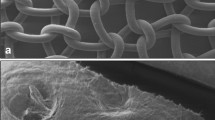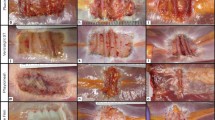Abstract
Permacol™ biological implant is a cross-linked porcine dermal collagen biomaterial that has been successfully used in abdominal wall repair. The purpose of this study is to examine biopsies of the implant after use in abdominal wall hernia repair and demonstrate its histological and immunohistochemical characteristics in vivo. Three male patients, ranging in age from 61 to 76 years, underwent biopsy of the implant and surrounding abdominal wall tissue at 16, 36, and 60 months after implantation. At 16 months, the implant demonstrated excellent tissue integration, cellular and neovascular response, and remodeling. The implant–host tissue interface showed seamless integration with no fibrosis. Tissue ingrowth into the material, new blood vessel formation, and remodeling of the host–tissue interface were observed. At approximately 36 months, organized remodeling of the implant into functional, predominately host tissue was generally seen. At more than 60 months, macroscopic and histological characteristics resembled functional human tissue with immunohistochemical evidence of the residual presence of porcine collagen. Permacol™ implant supports controlled and natural long-term remodeling into normal, functional host tissue.









Similar content being viewed by others
References
Abraham GA, Murray J, Billiar K et al (2000) Evaluation of the porcine intestinal collagen layer as a biomaterial. J Biomed Mater Res 51(3):442–452
Badhe SP, Lawrence TM, Smith FD et al (2008) An assessment of porcine dermal xenograft as an augmentation graft in the treatment of extensive rotator cuff tears. J Should Elb Surg 17(1 Suppl):35S–39S
Bellon JM, Bujan J, Contreras LA et al (1996) Similarity in behavior of polytetrafluoroethylene (ePTFE) prostheses implanted into different interfaces. J Biomed Mater Res 31(1):1–9
Billiar K, Murray J, Laude D et al (2001) Effects of carbodiimide crosslinking conditions on the physical properties of laminated intestinal submucosa. J Biomed Mater Res 56(1):101–108
Catena F, Ansaloni L, Gazzotti F et al (2007) Use of porcine dermal collagen graft (Permacol) for hernia repair in contaminated fields. Hernia 11(1):57–60
Chand B, Indeck M, Needleman B et al (2014) A retrospective study evaluating the use of Permacol surgical implant in incisional and ventral hernia repair. Int J Surg S1743–9191(14):00037–00045
Chavarriaga LF, Lin E, Losken A et al (2010) Management of complex abdominal wall defects using acellular porcine dermal collagen. Am Surg 76(1):96–100
Chave H, Ahmed S, Fu B et al (2006) Salvage of infected dermal collagen implants with topical negative pressure therapy. J Wound Care 15(4):156–158
Cobb GA, Shaffer J (2005) Cross-linked acellular porcine dermal collagen implant in laparoscopic ventral hernia repair: case-controlled study of operative variables and early complications. Int Surg 90(3 Suppl):S24–29
de Castro Bras LE, Shurey S, Sibbons PD (2012) Evaluation of crosslinked and non-crosslinked biologic prostheses for abdominal hernia repair. Hernia 16(1):77–89
Formichi MJ, Guidoin RG, Jausseran JM et al (1988) Expanded PTFE prostheses as arterial substitutes in humans: late pathological findings in 73 excised grafts. Ann Vasc Surg 2(1):14–27
Gaertner WB, Bonsack ME, Delaney JP (2007) Experimental evaluation of four biologic prostheses for ventral hernia repair. J Gastrointest Surg 11(10):1275–1285
Gupta A, Zahriya K, Mullens PL et al (2006) Ventral herniorrhaphy: experience with two different biosynthetic mesh materials, Surgisis and Alloderm. Hernia 10(5):419–425
Hammond TM, Chin-Aleong J, Navsaria H et al (2008a) Human in vivo cellular response to a cross-linked acellular collagen implant. Br J Surg 95(4):438–446
Hammond TM, Huang A, Prosser K et al (2008b) Parastomal hernia prevention using a novel collagen implant: a randomised controlled phase 1 study. Hernia 12(5):475–481
Hiles M, Record Ritchie RD, Altizer AM (2009) Are biologic grafts effective for hernia repair?: a systematic review of the literature. Surg Innov 16(1):26–37
Hsu PW, Salgado CJ, Kent K et al (2009) Evaluation of porcine dermal collagen (Permacol) used in abdominal wall reconstruction. J Plast Reconstr Aesthet Surg 62(11):1484–1489
Jin J, Rosen MJ, Blatnik J et al (2007) Use of acellular dermal matrix for complicated ventral hernia repair: does technique affect outcomes? J Am Coll Surg 205(5):654–660
Kemp PD, Cavallaro JF, Hastings DN (1995) Effects of carbodiimide crosslinking and load environment on the remodeling of collagen scaffolds. Tissue Eng 1(1):71–79
Kolker AR, Brown DJ, Redstone JS et al (2005) Multilayer reconstruction of abdominal wall defects with acellular dermal allograft (AlloDerm) and component separation. Ann Plast Surg 55(1):36–41, discussion 41–32
Konstantinovic ML, Ozog Y, Spelzini F et al (2010) Biomechanical findings in rats undergoing fascial reconstruction with graft materials suggested as an alternative to polypropylene. Neurourol Urodyn 29(3):488–493
Kuo YC, Mondschein JI, Soulen MC et al (2010) Drainage of collections associated with hernia mesh: is it worthwhile? J Vasc Interv Radiol 21(3):362–366
Macleod TM, Williams G, Sanders R et al (2005) Histological evaluation of Permacol as a subcutaneous implant over a 20-week period in the rat model. Br J Plast Surg 58(4):518–532
Matthews BD, Pratt BL, Pollinger HS et al (2003) Assessment of adhesion formation to intra-abdominal polypropylene mesh and polytetrafluoroethylene mesh. J Surg Res 114(2):126–132
O’Brien JA, Ignotz R, Montilla R et al (2011) Long-term histologic and mechanical results of a Permacol abdominal wall explant. Hernia 15(2):211–215
Parker DM, Armstrong PJ, Frizzi JD et al (2006) Porcine dermal collagen (Permacol) for abdominal wall reconstruction. Curr Surg 63(4):255–258
Saettele TM, Bachman SL, Costello CR et al (2007) Use of porcine dermal collagen as a prosthetic mesh in a contaminated field for ventral hernia repair: a case report. Hernia 11(3):279–285
Sandor M, Xu H, Connor J et al (2008) Host response to implanted porcine-derived biologic materials in a primate model of abdominal wall repair. Tissue Eng Part A 14(12):2021–2031
Sclafani AP, Romo T 3rd, Jacono AA et al (2001) Evaluation of acellular dermal graft (AlloDerm) sheet for soft tissue augmentation: a 1-year follow-up of clinical observations and histological findings. Arch Facial Plast Surg 3(2):101–103
Shaikh FM, Giri SK, Durrani S et al (2007) Experience with porcine acellular dermal collagen implant in one-stage tension-free reconstruction of acute and chronic abdominal wall defects. World J Surg 31(10):1966–1975
Author information
Authors and Affiliations
Corresponding author
Rights and permissions
About this article
Cite this article
Sibbons, P.D., Pullan, R.D. & de Castro Brás, L.E. Biopsies of Permacol™ implant in humans after use in abdominal wall repair: histological and immunohistochemical analysis. Comp Clin Pathol 24, 831–840 (2015). https://doi.org/10.1007/s00580-014-1990-y
Received:
Accepted:
Published:
Issue Date:
DOI: https://doi.org/10.1007/s00580-014-1990-y




